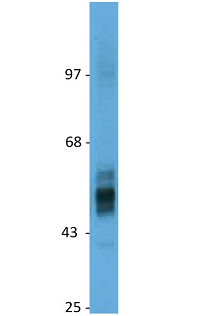Further Information
Alternate Names/Synonyms:
Solute Carrier Family 2, Facilitated Glucose Transporter Member 2; SLC2A2; Glucose Transporter Type 2, Liver
1mg/ml
32160000
liquid
Liquid. In PBS containing 10% glycerol and 0.02% Proclin 300.
After opening, prepare aliquots and store at -20°C. Avoid freeze/thaw cycles.
A synthetic peptide corresponding to 12 aa located near the C-terminus of human GLUT2.
Polyclonal Antibody. Recognizes human GLUT2. Applications: IHC, IP, WB. Source: Rabbit. GLUT2 belongs to the family of glucose transporters (GLUTs, encoded by the SLC2A genes), which comprises 14 isoforms. GLUT2 has a uniquely low affinity for glucose (Km ~ 17mmol/l), and can also use mannose, galactose and fructose as low-affinity substrates. However, it has a high affinity for glucosamine (Km ~ 0.8mmol/l). GLUT2 is expressed in liver, intestine, kidney and pancreatic islet beta cells, as well as in the central nervous system, in neurons, astrocytes and tanycytes. Physiological studies of genetically modified mice have revealed a role for GLUT2 in several regulatory mechanisms. GLUT2 is also the major glucose transporter in the plasma membrane of hepatocytes. In pancreatic beta cells, GLUT2 is required for glucose-stimulated insulin secretion. In the nervous system, GLUT2-dependent glucose-sensing controls feeding, thermoregulation and pancreatic islet cell mass and function, as well as sympathetic and parasympathetic activities.
P11168
Plastic Vial
GLUT2 belongs to the family of glucose transporters (GLUTs, encoded by the SLC2A genes), which comprises 14 isoforms. GLUT2 has a uniquely low affinity for glucose (Km ~ 17mmol/l), and can also use mannose, galactose and fructose as low-affinity substrates. However, it has a high affinity for glucosamine (Km ~ 0.8mmol/l). GLUT2 is expressed in liver, intestine, kidney and pancreatic islet beta cells, as well as in the central nervous system, in neurons, astrocytes and tanycytes. Physiological studies of genetically modified mice have revealed a role for GLUT2 in several regulatory mechanisms. GLUT2 is also the major glucose transporter in the plasma membrane of hepatocytes. In pancreatic beta cells, GLUT2 is required for glucose-stimulated insulin secretion. In the nervous system, GLUT2-dependent glucose-sensing controls feeding, thermoregulation and pancreatic islet cell mass and function, as well as sympathetic and parasympathetic activities.
>95% (SDS-PAGE)
Rabbit
Recognizes human GLUT2.
Non-hazardous
Primary Antibodies
12352203
Stable for at least 1 year after receipt when stored at -20°C.



